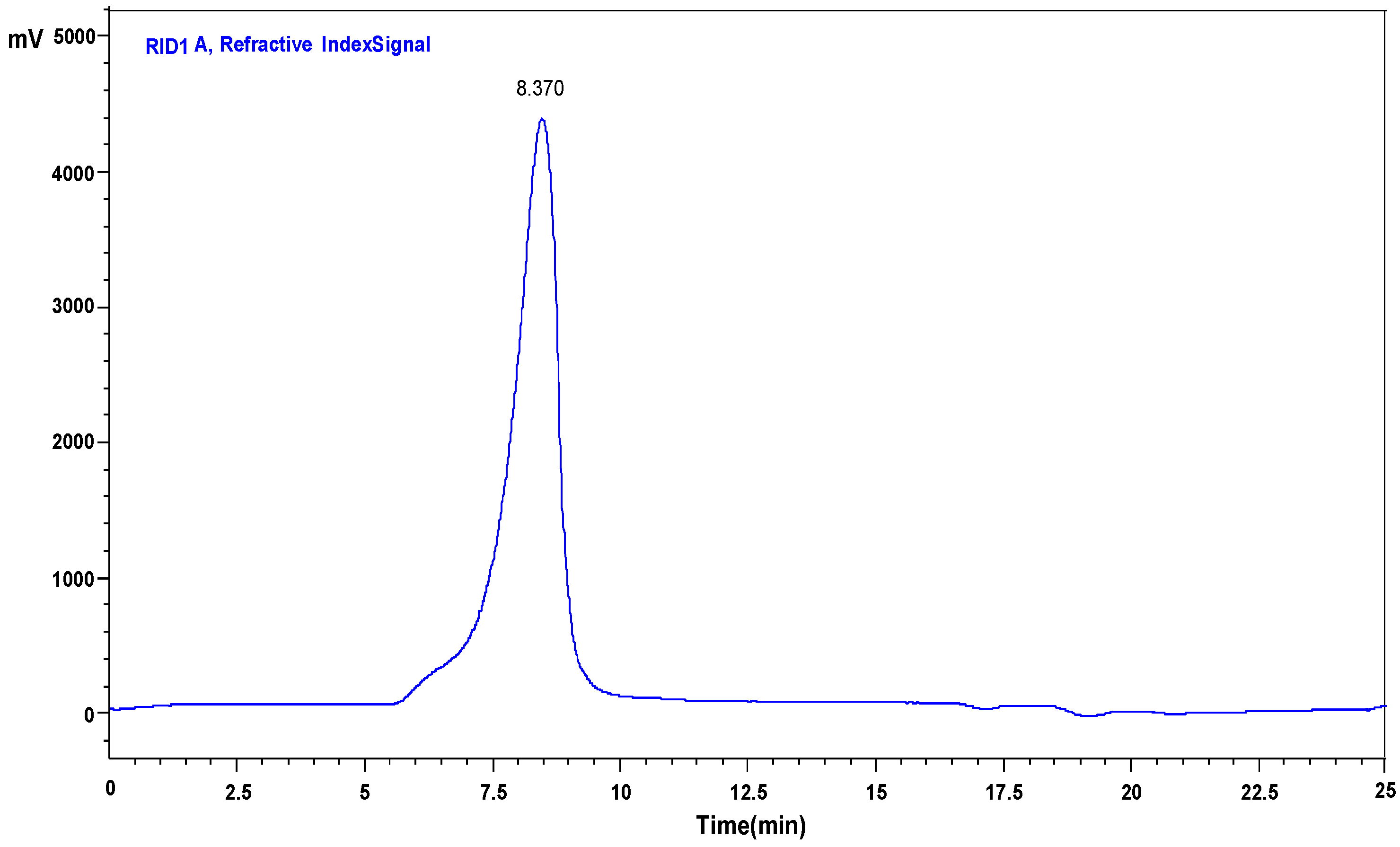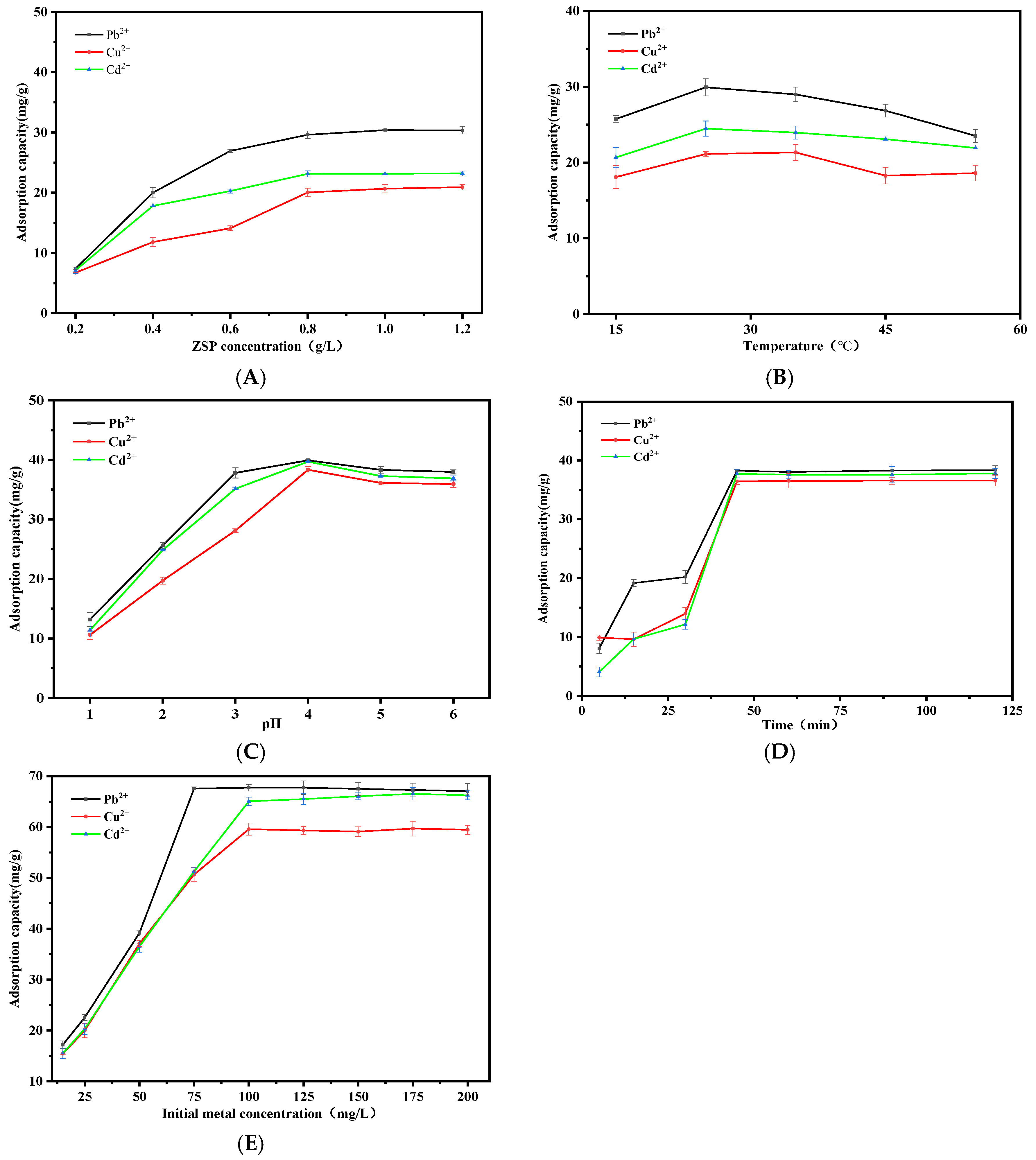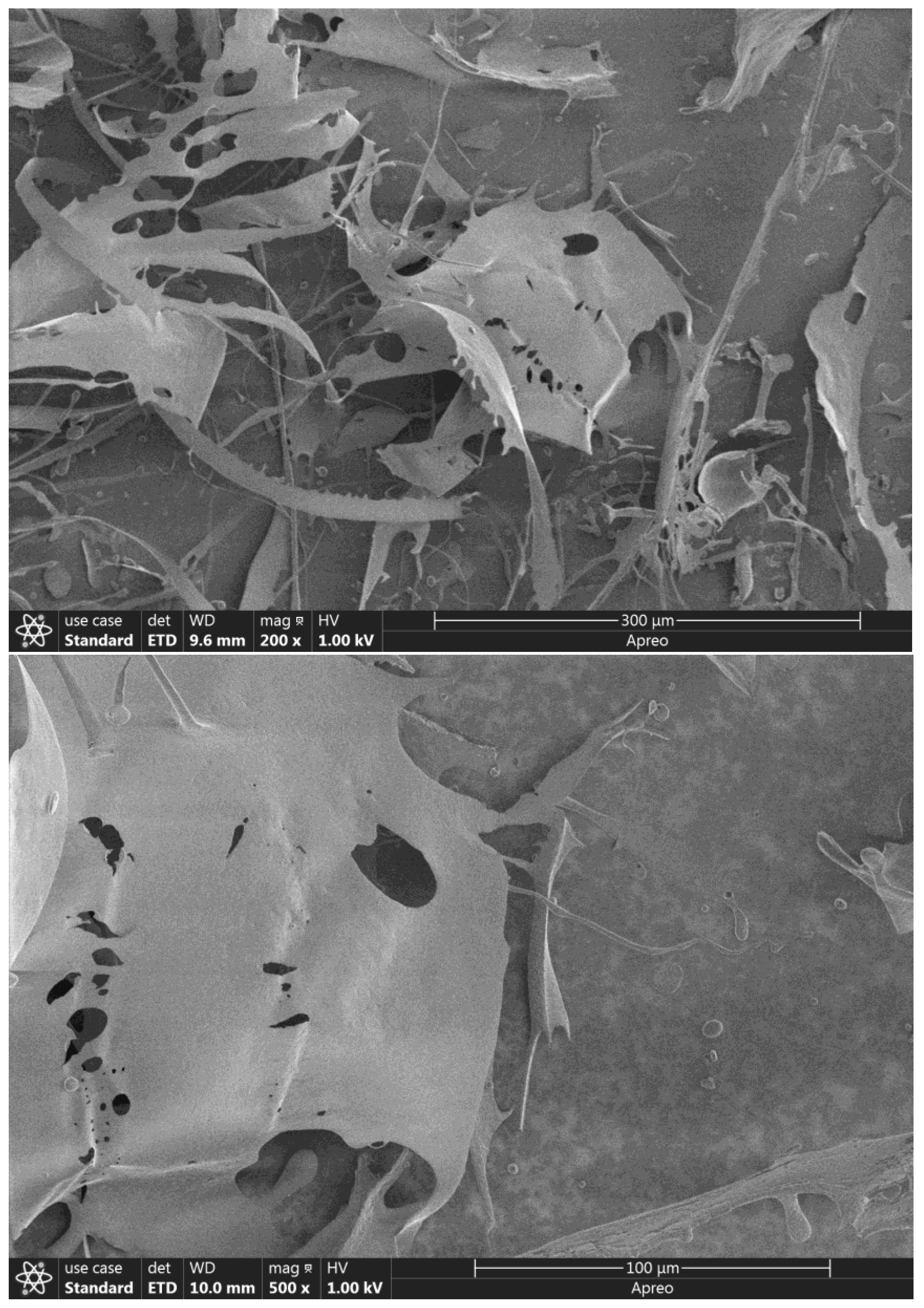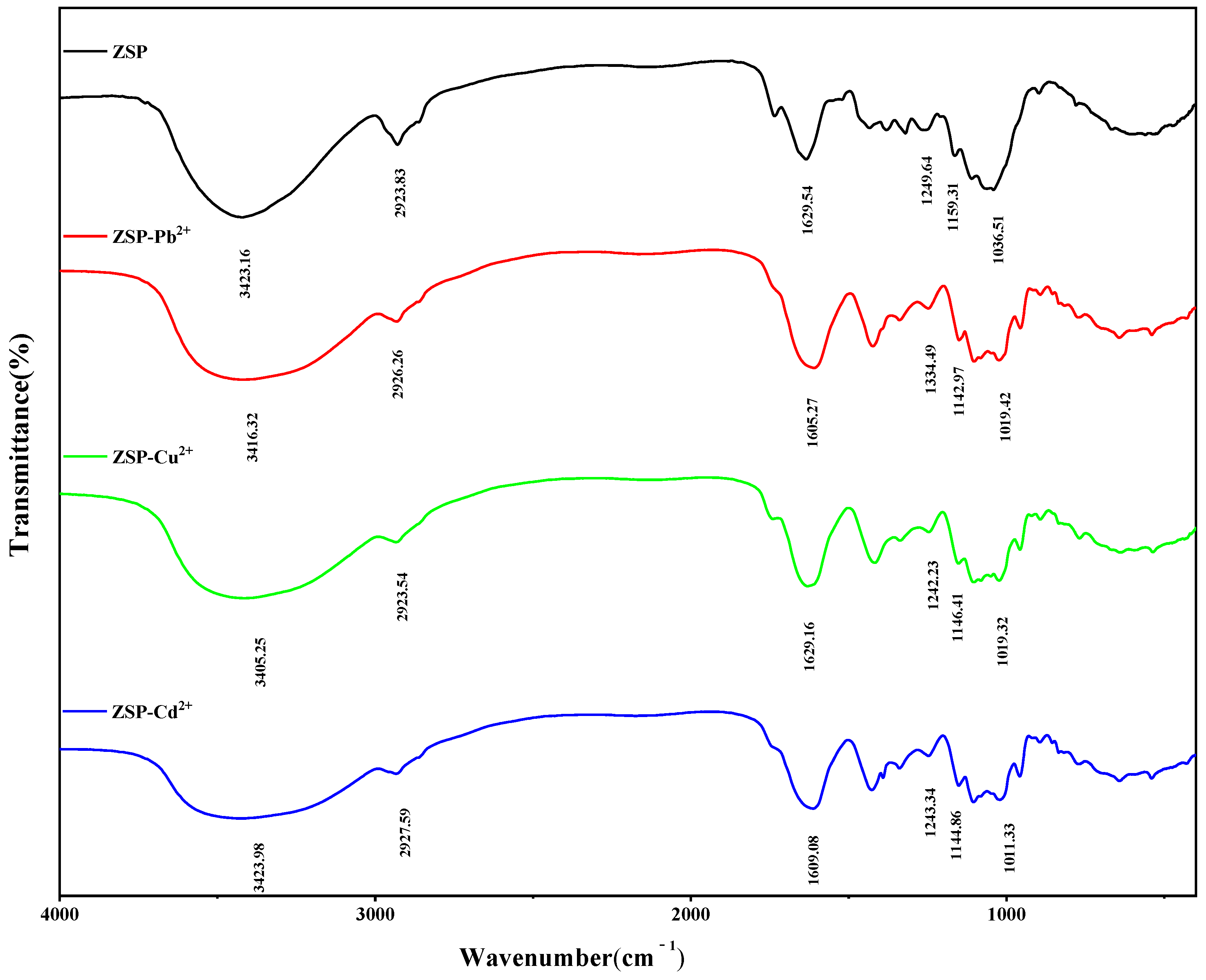Biosorption Characteristic and Cytoprotective Effect of Pb2+, Cu2+ and Cd2+ by a Novel Polysaccharide from Zingiber strioatum
Abstract
:1. Introduction
2. Results and Discussion
2.1. Purification and Composition of ZSP
2.2. Adsorption Behaviors
2.2.1. Effect of Initial ZSP Concentration
2.2.2. Effect of Temperature on Pb2+, Cu2+ and Cd2+ Adsorption
2.2.3. Effect of pH on Pb2+, Cu2+ and Cd2+ Adsorption
2.2.4. Adsorption Kinetics Study
2.2.5. Biosorption Isotherm Study
2.3. Preliminary Study on Adsorption Mechanism
2.3.1. The Surface Structure and EDX Analysis of ZSP
2.3.2. X-ray Photoelectron Spectroscopy (XPS) Analysis of ZSP
2.3.3. FT-IR Spectroscopy Analysis of ZSP
2.4. Protective Effects of ZSP on Cells Treated with Pb2+, Cu2+ and Cd2+
3. Materials and Methods
3.1. Zingiber strioatum and Chemical Reagents
3.2. Biosorbent Preparation
3.3. Metal Solution Preparation
3.4. Adsorption Behaviors
3.4.1. Effect of ZSP Concentration
3.4.2. Effect of Temperature
3.4.3. Effect of pH
3.4.4. Adsorption Kinetics
3.4.5. Isothermal Adsorption
3.5. Preliminary Study on Adsorption Mechanism
3.5.1. Surface Characteristics of ZSP and Energy Dispersive X-ray Detector (EDX) Analysis
3.5.2. X-ray Photoelectron Spectroscopy (XPS) Analysis
3.5.3. Infrared Spectroscopy (FT-IR) Analysis
3.6. Cytoprotective Effect of ZSP
3.7. Statistical Analysis
4. Conclusions
Supplementary Materials
Author Contributions
Funding
Institutional Review Board Statement
Informed Consent Statement
Data Availability Statement
Conflicts of Interest
Sample Availability
References
- Hoang, H.G.; Chiang, C.F.; Lin, C.; Wu, C.Y.; Lee, C.W.; Cheruiyot, N.K.; Tran, H.T.; Bui, X.T. Human health risk simulation and assessment of heavy metal contamination in a river affected by industrial activities. Environ. Pollut. 2021, 285, 117414. [Google Scholar] [CrossRef] [PubMed]
- Arun, K.B.; Madhavan, A.; Sindhu, R.; Emmanual, S.; Binod, P.; Pugazhendhi, A.; Sirohi, R.; Reshmy, R.; Awasthi, M.K.; Gnansounou, E.; et al. Probiotics and gut microbiome—Prospects and challenges in remediating heavy metal toxicity. J. Hazard. Mater. 2021, 420, 126676. [Google Scholar] [CrossRef] [PubMed]
- Mobasherpour, I.; Salahi, E.; Asjodi, A. Research on the Batch and Fixed-Bed Column Performance of Red Mud Adsorbents for Lead Removal. Can. Chem. Trans. 2014, 4, 83–96. [Google Scholar] [CrossRef] [Green Version]
- Choma, A.; Nowak, K.; Komaniecka, I.; Waśko, A.; Pleszczyńska, M.; Siwulski, M.; Wiater, A. Chemical characterization of alkali-soluble polysaccharides isolated from a Boletus edulis (Bull.) fruiting body and their potential for heavy metal biosorption. Food Chem. 2018, 266, 329–334. [Google Scholar] [CrossRef] [PubMed]
- Liu, Y.; Li, H.; Fan, C.; Min, W.; Gao, Y. Optimization of Adsorption Procest and Characterization of Cu2+ and Cd2+ by Athelia rolfsii Polysaccharide. Sci. Technol. Food Ind. 2020, 41, 175–181. (In Chinese) [Google Scholar] [CrossRef]
- Nowak, K.; Wiater, A.; Choma, A.; Wiącek, D.; Bieganowski, A.; Siwulski, M.; Waśko, A. Fungal (1 → 3)-α-d-glucans as a new kind of biosorbent for heavy metals. Int. J. Biol. Macromol. 2019, 137, 960–965. [Google Scholar] [CrossRef] [PubMed]
- Xiao-jing, H.; Hai-dong, G.; Ting-ting, Z.; Yu, J.; Juan-juan, Q. Biosorption mechanism of Cu2+ by innovative immobilized spent substrate of fragrant mushroom biomass. Ecol. Eng. 2014, 73, 509–513. [Google Scholar] [CrossRef]
- Hou, W.; Ma, Z.; Sun, L.; Han, M.; Lu, J.; Li, Z.; Mohamad, O.A.; Wei, G. Extracellular polymeric substances from copper-tolerance Sinorhizobium meliloti immobilize Cu2+. J. Hazard. Mater. 2013, 261, 614–620. [Google Scholar] [CrossRef]
- Shuhong, Y.; Meiping, Z.; Hong, Y.; Han, W.; Shan, X.; Yan, L.; Jihui, W. Biosorption of Cu2+, Pb2+ and Cr6+ by a novel exopolysaccharide from Arthrobacter ps-5. Carbohydr. Polym. 2014, 101, 50–56. [Google Scholar] [CrossRef] [PubMed]
- Facchi, D.P.; Cazetta, A.L.; Canesin, E.A.; Almeida, V.C.; Bonafé, E.G.; Kipper, M.J.; Martins, A.F. New magnetic chitosan/alginate/Fe3O4@SiO2 hydrogel composites applied for removal of Pb(II) ions from aqueous systems. Chem. Eng. J. 2018, 337, 595–608. [Google Scholar] [CrossRef]
- Zhu, Y.M.; Pan, L.C.; Zhang, L.J.; Yin, Y.; Zhu, Z.Y.; Sun, H.Q.; Liu, C.Y. Chemical structure and antioxidant activity of a polysaccharide from Siraitia grosvenorii. Int. J. Biol. Macromol. 2020, 165, 1900–1910. [Google Scholar] [CrossRef] [PubMed]
- Song, Q.; Zhu, Z. Using Cordyceps militaris extracellular polysaccharides to prevent Pb2+-induced liver and kidney toxicity by activating Nrf2 signals and modulating gut microbiota. Food Funct. 2020, 11, 9226–9239. [Google Scholar] [CrossRef]
- Gu, S.; Sun, H.; Zhang, X.; Huang, F.; Pan, L.; Zhu, Z. Structural characterization and inhibitions on alpha-glucosidase and alpha-amylase of alkali-extracted water-soluble polysaccharide from Annona squamosa residue. Int. J. Biol. Macromol. 2021, 166, 730–740. [Google Scholar] [CrossRef] [PubMed]
- Tian, W.; Dai, L.; Lu, S.; Luo, Z.; Qiu, Z.; Li, J.; Li, P.; Du, B. Effect of Bacillus sp. DU-106 fermentation on Dendrobium officinale polysaccharide: Structure and immunoregulatory activities. Int. J. Biol. Macromol. 2019, 135, 1034–1042. [Google Scholar] [CrossRef] [PubMed]
- Fella-Temzia, S.; Yalaoui-Guellala, D.; Rodriguez-Carvajalb, M.A.; Belhadic, D.; Madania, K.; Kaci, Y. Removal of lead by exopolysaccharides from Paenibacillus peoriae strainTS7 isolated from rhizosphere of durum wheat. Biocatal. Agric. Biotechnol. 2018, 16, 425–432. [Google Scholar] [CrossRef]
- Bhunia, B.; Uday, U.S.P.; Oinam, G.; Mondal, A.; Bandyopadhyay, T.K.; Tiwari, O.N. Characterization, genetic regulation and production of cyanobacterial exopolysaccharides and its applicability for heavy metal removal. Carbohydr. Polym. 2018, 179, 228–243. [Google Scholar] [CrossRef]
- Zhou, W.; Wang, J.; Shen, B.; Hou, W.; Zhang, Y. Biosorption of copper(II) and cadmium(II) by a novel exopolysaccharide secreted from deep-sea mesophilic bacterium. Colloids Surf. B Biointerfaces 2009, 72, 295–302. [Google Scholar] [CrossRef] [PubMed]
- Qi, X.; Tong, X.; Pan, W.; Zeng, Q.; You, S.; Shen, J. Recent advances in polysaccharide-based adsorbents for wastewater treatment. J. Clean. Prod. 2021, 315, 128221. [Google Scholar] [CrossRef]
- Huang, Y.J.; Wu, J.R.; Zhu, L.; Zhan, X.B. Adsorption of heavy metal by polysaccharide of Cyanobacteria from Taihu Lake. Chin. J. Bioprocess Eng. 2019, 17, 214–219. (In Chinese) [Google Scholar]
- Naseem, K.; Farooqi, Z.H.; Begum, R.; Rehman, M.Z.U.; Shahbaz, A.; Farooq, U.; Ali, M.; Rahman, H.M.A.U.; Irfan, A.; Al-Sehemi, A.G. Removal of Cadmium (II) from Aqueous Medium Using Vigna radiata Leave Biomass: Equilibrium Isotherms, Kinetics and Thermodynamics. Z. Für Phys. Chem. 2019, 233, 669–690. [Google Scholar] [CrossRef]
- Malkoc, E. Ni(II) removal from aqueous solutions using cone biomass of Thuja orientalis. J. Hazard. Mater. 2006, 137, 899–908. [Google Scholar] [CrossRef]
- Concórdio-Reis, P.; Reis, M.A.M.; Freitas, F. Biosorption of Heavy Metals by the Bacterial Exopolysaccharide FucoPol. Appl. Sci. 2020, 10, 6708. [Google Scholar] [CrossRef]
- Shibaev, A.V.; Muravlev, D.A.; Muravleva, A.K.; Matveev, V.V.; Chalykh, A.E.; Philippova, O.E. pH-Dependent Gelation of a Stiff Anionic Polysaccharide in the Presence of Metal Ions. Polymers 2020, 12, 868. [Google Scholar] [CrossRef] [PubMed]
- Feng, M.; Chen, X.; Li, C.; Nurgul, R.; Dong, M. Isolation and identification of an exopolysaccharide-producing lactic acid bacterium strain from Chinese Paocai and biosorption of Pb(II) by its exopolysaccharide. J. Food Sci. 2012, 77, T111–T117. [Google Scholar] [CrossRef] [PubMed]
- Huang, Y.; Wang, Z. Preparation of composite aerogels based on sodium alginate, and its application in removal of Pb2+ and Cu2+ from water. Int. J. Biol. Macromol. 2018, 107, 741–747. [Google Scholar] [CrossRef]
- Siao, F.Y.; Lu, J.F.; Wang, J.S.; Inbaraj, B.S.; Chen, B.H. In vitro binding of heavy metals by an edible biopolymer poly(gamma-glutamic acid). J. Agric. Food Chem. 2009, 57, 777–784. [Google Scholar] [CrossRef] [PubMed]
- Khan, T.A.; Mukhlif, A.A.; Khan, E.A. Uptake of Cu2+ and Zn2+ from simulated wastewater using muskmelon peel biochar: Isotherm and kinetic studies. Egypt. J. Basic Appl. Sci. 2019, 4, 236–248. [Google Scholar] [CrossRef] [Green Version]
- Zhu, Q.; Li, Z. Hydrogel-supported nanosized hydrous manganese dioxide: Synthesis, characterization, and adsorption behavior study for Pb2+, Cu2+, Cd2+ and Ni2+ removal from water. Chem. Eng. J. 2015, 281, 69–80. [Google Scholar] [CrossRef]
- Swiatkowski, A.; Pakula, M.; Biniak, S.; Walczyk, M. Influence of the surface chemistry of modified activated carbon on its electrochemical behaviour in the presence of lead(II) ions. Carbon 2004, 42, 3057–3069. [Google Scholar] [CrossRef]
- Sevim, A.M.; Hojiyev, R.; Gül, A.; Çelik, M.S. An investigation of the kinetics and thermodynamics of the adsorption of a cationic cobalt porphyrazine onto sepiolite. Dye. Pigment. 2011, 88, 25–38. [Google Scholar] [CrossRef]
- Lu, H.; Zhang, W.; Yang, Y.; Huang, X.; Wang, S.; Qiu, R. Relative distribution of Pb2+ sorption mechanisms by sludge-derived biochar. Water Res. 2012, 46, 854–862. [Google Scholar] [CrossRef] [PubMed]
- Yu, Z.; Ming, G.; Kaiping, W.; Zhixiang, C.; Liquan, D.; Jingyu, L.; Fang, Z. Structure, chain conformation and antitumor activity of a novel polysaccharide from Lentinus edodes. Fitoterapia 2010, 81, 1163–1170. [Google Scholar] [CrossRef] [PubMed]
- Liu, F.; Zhu, Z.Y.; Sun, X.; Gao, H.; Zhang, Y.M. The preparation of three selenium-containing Cordyceps militaris polysaccharides: Characterization and anti-tumor activities. Int. J. Biol. Macromol. 2017, 99, 196–204. [Google Scholar] [CrossRef] [PubMed]
- Mitić, Ž.; Nikolić, G.S.; Cakić, M.; Premović, P.; Ilić, L. FTIR spectroscopic characterization of Cu(II) coordination compounds with exopolysaccharide pullulan and its derivatives. J. Mol. Struct. 2009, 924–926, 264–273. [Google Scholar] [CrossRef]
- Tabarsa, M.; You, S.; Yelithao, K.; Palanisamy, S.; Prabhu, N.M.; Nan, M. Isolation, structural elucidation and immuno-stimulatory properties of polysaccharides from Cuminum cyminum. Carbohydr. Polym. 2020, 230, 115636. [Google Scholar] [CrossRef] [PubMed]
- Qi, X.; Yuan, Y.; Zhang, J.; Bulte, J.W.M.; Dong, W. Oral Administration of Salecan-Based Hydrogels for Controlled Insulin Delivery. J. Agric. Food Chem. 2018, 66, 10479–10489. [Google Scholar] [CrossRef] [PubMed]
- Qi, X.; Liu, R.; Chen, M.; Li, Z.; Qin, T.; Qian, Y.; Zhao, S.; Liu, M.; Zeng, Q.; Shen, J. Removal of copper ions from water using polysaccharide-constructed hydrogels. Carbohydr. Polym. 2019, 209, 101–110. [Google Scholar] [CrossRef]
- Li, H.; Xia, X.; Zang, J.; Tan, X.; Wang, Z.; Xu, X.; Du, M. Oyster (Crassostrea gigas) ferritin can efficiently reduce the damage of Pb2+ in vivo by electrostatic attraction. Int. J. Biol. Macromol. 2022, 210, 365–376. [Google Scholar] [CrossRef] [PubMed]
- Pan, L.C.; Sun, Y.Y.; Zhang, X.L.; Zhu, Z.Y.; Liu, C.Y.; Sun, H.Q.; Geng, X.Q.; Jiang, W.; Wang, J.H. Structure, antioxidant property and protection on PC12 of a polysaccharide isolated and screened from Abelmoschus esculentus L. Moench (okra). Nat. Prod. Res. 2022, 36, 1441–1447. [Google Scholar] [CrossRef] [PubMed]
- Qi, X.; Wu, L.; Su, T.; Zhang, J.; Dong, W. Polysaccharide-based cationic hydrogels for dye adsorption. Colloids Surf. B Biointerfaces 2018, 170, 364–372. [Google Scholar] [CrossRef] [PubMed]
- Gupta, V.K.; Rastogi, A. Biosorption of lead from aqueous solutions by green algae Spirogyra species: Kinetics and equilibrium studies. J. Hazard. Mater. 2008, 152, 407–414. [Google Scholar] [CrossRef] [PubMed]
- Liu, W.; Liu, Y.; Zhu, R.; Yu, J.; Lu, W.; Pan, C.; Yao, W.; Gao, X. Structure characterization, chemical and enzymatic degradation, and chain conformation of an acidic polysaccharide from Lycium barbarum L. Carbohydr. Polym. 2016, 147, 114–124. [Google Scholar] [CrossRef] [PubMed]








| Pseudo First-Order Model | Pseudo Second-Order Model | |||||
|---|---|---|---|---|---|---|
| K1 | qe | R2 | K2 | qe | R2 | |
| ZSP-Pb2+ | 0.006 | 18.93 | 0.6758 | 0.0015 | 40.32 | 0.9919 |
| ZSP-Cu2+ | 0.035 | 10.93 | 0.6579 | 0.0024 | 20.53 | 0.9925 |
| ZSP-Cd2+ | 0.029 | 13.79 | 0.6770 | 0.0009 | 33.89 | 0.9515 |
| Langmuir Isotherm Model | Freundlich Isotherm Model | |||||
|---|---|---|---|---|---|---|
| Qm (mg/g) | KL (L/mg) | R2 | KF (mg/g) | n | R2 | |
| ZSP-Pb2+ | 67.73 | 0.2478 | 0.9969 | 17.95 | 2.879 | 0.8820 |
| ZSP-Cu2+ | 59.34 | 0.2780 | 0.9721 | 13.78 | 2.358 | 0.9128 |
| ZSP-Cd2+ | 65.05 | 0.2521 | 0.9653 | 19.13 | 2.160 | 0.9456 |
| Sample | Functional Groups | |||||
|---|---|---|---|---|---|---|
| O-H | CH2 | C=O | C-OH | C-O-C | O-H or Phosphate | |
| ZSP | 3423.16 | 2923.83 | 1629.54 | 1249.64 | 1159.31 | 1036.51 |
| ZSP + Pb2+ | 3416.32 | 2926.26 | 1605.27 | 1243.11 | 1142.97 | 1019.42 |
| ZSP + Cu2+ | 3405.25 | 2923.54 | 1629.16 | 1242.23 | 1146.41 | 1019.32 |
| ZSP + Cd2+ | 3423.98 | 2927.59 | 1609.08 | 1243.34 | 1144.86 | 1011.33 |
Publisher’s Note: MDPI stays neutral with regard to jurisdictional claims in published maps and institutional affiliations. |
© 2022 by the authors. Licensee MDPI, Basel, Switzerland. This article is an open access article distributed under the terms and conditions of the Creative Commons Attribution (CC BY) license (https://creativecommons.org/licenses/by/4.0/).
Share and Cite
Jiang, W.; Hu, Y.; Zhu, Z. Biosorption Characteristic and Cytoprotective Effect of Pb2+, Cu2+ and Cd2+ by a Novel Polysaccharide from Zingiber strioatum. Molecules 2022, 27, 8036. https://doi.org/10.3390/molecules27228036
Jiang W, Hu Y, Zhu Z. Biosorption Characteristic and Cytoprotective Effect of Pb2+, Cu2+ and Cd2+ by a Novel Polysaccharide from Zingiber strioatum. Molecules. 2022; 27(22):8036. https://doi.org/10.3390/molecules27228036
Chicago/Turabian StyleJiang, Wei, Ying Hu, and Zhenyuan Zhu. 2022. "Biosorption Characteristic and Cytoprotective Effect of Pb2+, Cu2+ and Cd2+ by a Novel Polysaccharide from Zingiber strioatum" Molecules 27, no. 22: 8036. https://doi.org/10.3390/molecules27228036
APA StyleJiang, W., Hu, Y., & Zhu, Z. (2022). Biosorption Characteristic and Cytoprotective Effect of Pb2+, Cu2+ and Cd2+ by a Novel Polysaccharide from Zingiber strioatum. Molecules, 27(22), 8036. https://doi.org/10.3390/molecules27228036





